|
October 2018 - December 2018 |
| |
|
|
 |
|
 |
| |
Publisher: Chairman Gong-Ru Lin Editors: Professor
Hsiang-Chieh Lee, Ms. Hsiao-wen Lin February 28, 2019 |
| |
|
 |
|
Congratulations! GIPO Professor Sheng-Lung Huang receives the title of "2019 OSA Fellow".
Congratulations! GIPO Professor Chung-Chih Wu receives the title of “Micron Chair Professor”.
Congratulations to GIPO Professor Chao-Hsin Wu on being awarded the “Excellent Young Electrical Engineer” Prize of the Chinese Institute of Electrical Engineering!
Congratulations to GIPO Professors Lon A. Wang, Lung-Han Peng, Guo-Dung Su, Yuh-Renn Wu and Hsiang-Chieh Lee, members of the EECS softball team, for winning 3rd place in the 2018 slow-pitch softball tournament of NTU 4 colleges!
Congratulations to the following Ph.D. students and instructing professors on winning the 2018 CTCI Foundation Science & Technology scholarship! Here below is the winners’ list:
|
Student |
Award |
Adviser |
|
Rajendran Soundararajan |
2018 CTCI Foundation Science & Technology scholarship - International Graduate Students living subsidy (Ph.D. student) |
Sheng-Lung Huang |
|
Po-Han Chang |
2018 CTCI Foundation Science & Technology scholarship - research scholarship (Ph.D. student) |
Chih-I Wu |
Congratulations to the following master and Ph.D. students on being awarded the “OPTIC 2018 Student Paper Award”, under the instruction of each of the following advisers:
|
Student |
Award |
Adviser |
|
Bhaskar Jyoti Borah
|
OPTIC 2018 Student Paper Award – Ph.D. student Thesis title: Development of Multiphoton Microscopy System for Sub-Micron Resolution imaging with an ultra-large Field-of-View
|
Chi-Kuang Sun |
|
Ting-Yu Huang |
OPTIC 2018 Student Paper Award – master student Thesis title: High Speed 850 nm VCSEL Operating Error-Free NRZ-OOK Modulation up to 50 Gb/s
|
Chao-Hsin Wu |
|
Li-Yu Yu |
OPTIC 2018 Student Paper Award – master student Thesis title: Enhancement of Subwavelength Resolution by Depositing Nanoparticles on Microlens
|
Guo-Dung Su |
|
Sheng-Tse Chen |
OPTIC 2018 Student Paper Award – master student Thesis title: Treatment Assessment of Solar Lentigines by Using Clinical Harmonic Generation Microscopy
|
Chi-Kuang Sun |
|
Wen-Cheng Ding |
OPTIC 2018 Student Paper Award – master student Thesis title: Post treatment of red quantum dot light emitting diode
|
Jiun-Haw Lee |
|
Ren-Shiun Liou |
OPTIC 2018 Student Paper Award – master student Thesis title: Three Dimensional Simulation on the Transport and Quantum Efficiency of UVC-LEDs with Random Alloy Fluctuations
|
Yuh-Renn Wu |
|
Hong-Yi Hu |
OPTIC 2018 Student Paper Award – master student Thesis title: All-Solution-Processed Perovskite Solar Cells with AgNWs Top Electrodes
|
I-Chun Cheng |
|
Chia-Chun Wu |
OPTIC 2018 Student Paper Award – master student Thesis title: Transparent Flexible a-IGZO Thin-Film Transistors
|
I-Chun Cheng |
Congratulations to GIPO master student Cheng-Yi Huang on winning, under the instruction of Professor Gong-Ru Lin,“the 1st Master Thesis Prize of 2018 NTU Lam Research Award”!
|
|
 |
|
 |
|
| |
|
 |
|
September “GIPO Colloquium” Highlights
(Compiled by Li-Chi Yao) |
|
|
2:20 pm, Sep. 21 (Fri.), 2018 |
|
Speaker: |
Professor Tsai-Wen Chen, Institute of Neuroscience, National Yang-Ming University |
|
Topic: |
In vivo imaging of calcium and electrical signals in single hippocampal neurons |
|
|
GIPO had the honor of inviting Professor Tsai-Wen Chen to deliver a speech concerning “In vivo imaging of calcium and electrical signals in single hippocampal neurons” at auditorium 101, Barry Lam Hall, on Sep. 21 (Fri.). His speech was marvelous, rich in content and the professor interacted very well with students. GIPO teachers and students attended the event with enthusiasm and benefitted a great deal from it. |
| |
|
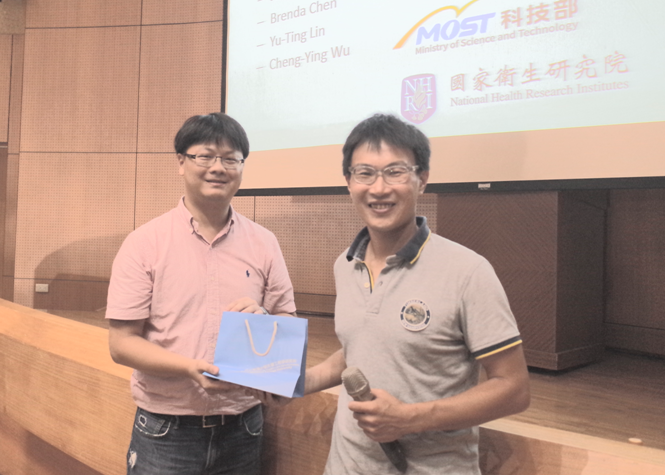 |
|
Professor Tsai-Wen Chen (right) and GIPO Professor Hsiang-Chieh Lee (left) |
|
|
October “GIPO Colloquium” Highlights
(Compiled by Li-Chi Yao) |
|
|
2:20 pm, Oct. 5 (Fri.), 2018 |
|
Speaker: |
Professor Jiashing Yu, Dept. of Chemical Engineering, NTU |
|
Topic:
|
Poly(3,4-ethylenedioxythiophene)-based Bioelectrodes with Designed Chemical and Topographical Cues to Manipulate the Behavior of Neural Cells |
|
|
Professor Jiashing Yu visited GIPO and delivered a speech at auditorium 105, EE Building II, on Oct. 5 (Fri.). She came at the invitation of GIPO Professor Hsiang-Chieh Lee, to deliver a speech concerning “Poly(3,4-ethylenedioxythiophene)-based Bioelectrodes with Designed Chemical and Topographical Cues to Manipulate the Behavior of Neural Cells”. Her speech was fascinating and the professor interacted very well with students. GIPO teachers and students attended the event with enthusiasm and benefitted a great deal from it. |
|
|
|
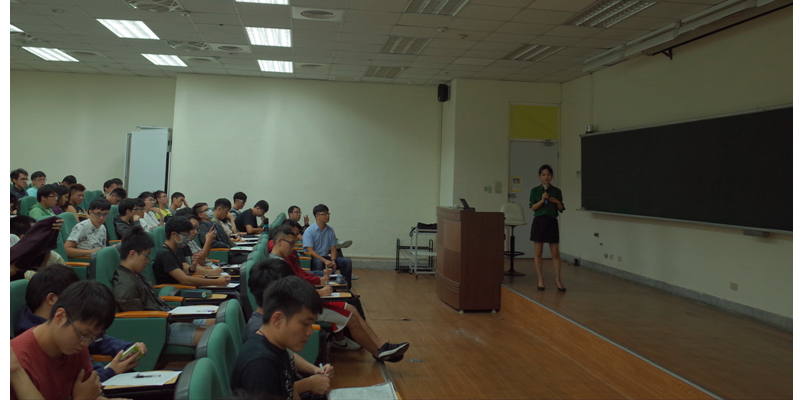 |
|
Professor Jiashing Yu, the speaker |
|
|
|
2:20 pm, Oct. 12 (Fri.), 2018 |
|
Speaker: |
Professor Shang-Hua Yang, Institute of Electronics Engineering, National Tsing Hua University |
|
Topic: |
Advanced Plasmonic Photoconductive Optoelectronics |
|
|
GIPO had the honor of inviting Professor Shang-Hua Yang to deliver a speech concerning “Advanced Plasmonic Photoconductive Optoelectronics” at auditorium 101, Barry Lam Hall on Oct. 12 (Fri.). His speech was informative and the professor interacted very well with students. GIPO teachers and students attended the event with enthusiasm and benefitted a great deal from it. |
| |
|
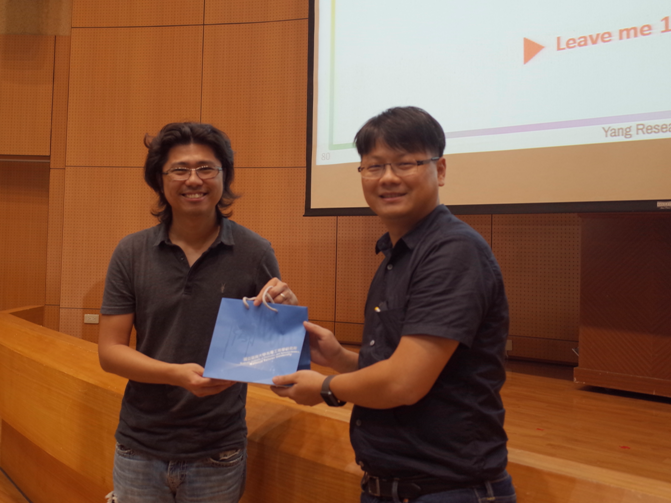 |
|
Professor Shang-Hua Yang (left) and GIPO Professor Hsiang-Chieh Lee (right) |
|
|
|
2:20 pm, Oct. 19 (Fri.), 2018 |
|
Speaker: |
Professor Ming-Chang Lee, Department of Electrical Engineering & Institute of Photonics Technologies, National Tsing Hua University |
|
Topic: |
Manipulation and Interrogation of Colloidal Microsphere Cavities for Optofluidic Applications |
|
|
Professor Ming-Chang Lee visited GIPO, at the invitation of GIPO Professor Hsiang-Chieh Lee, on Oct. 19 (Fri.) and delivered a speech concerning “Manipulation and Interrogation of Colloidal Microsphere Cavities for Optofluidic Applications” at auditorium 105, EE Building II. His speech was marvelous, rich in content and the professor engaged very well with students. GIPO teachers and students attended the event with enthusiasm and benefitted a great deal from it. |
| |
|
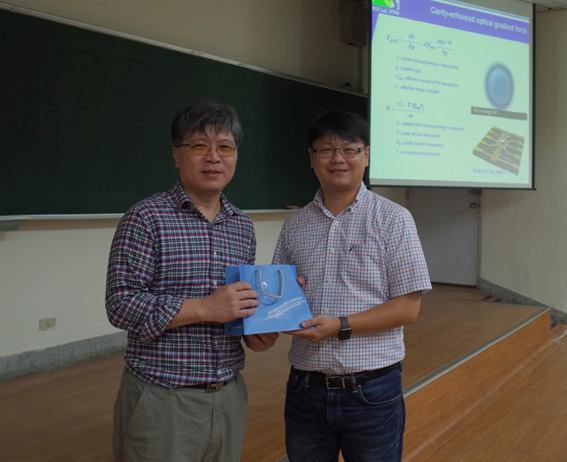 |
|
Professor Ming-Chang Lee (left) and GIPO Professor Hsiang-Chieh Lee (right) |
|
|
November “GIPO Colloquium” Highlights
(Compiled by Li-Chi Yao) |
|
Time: |
2:20 pm, Nov. 2 (Fri.), 2018 |
|
Speaker: |
Professor Yu-Cheng Chen, Nanyang Technological University, Singapore |
|
Topic:
|
Bio-Lasers: An Emerging Field Bridging Laser Photonics and Biomedicine |
|
|
We had the honor of inviting Professor Yu-Cheng Chen to deliver a speech concerning “Bio-Lasers: An Emerging Field Bridging Laser Photonics and Biomedicine” at auditorium 105, EE Building II. on Nov. 2 (Fri.). Professor Yo-Cheng Chen was a GIPO master graduate in 2012, went to the U.S., and then obtained his doctoral degree in biomedical engineering from Michigan University. He is currently teaching at Nanyang Technological University of Singapore, and is truly an outstanding alumnus living abroad. His speech was splendid, rich in contents and engaged students. GIPO teachers and students attended the event with enthusiasm and learned a great deal. |
|
|
|
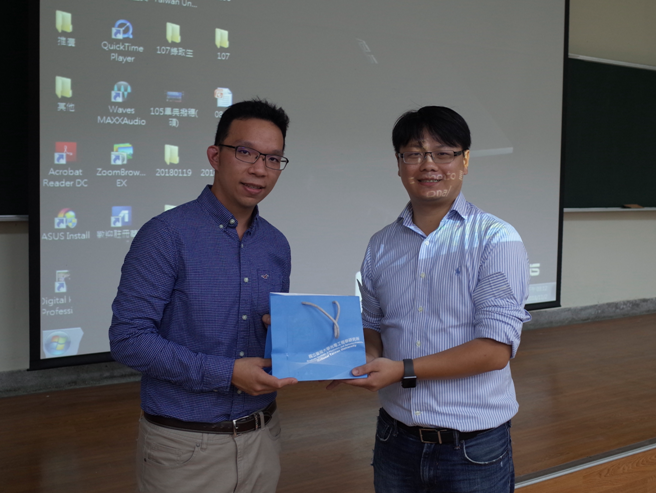 |
|
Professor Yu-Cheng Chen (left) and GIPO Professor Hsiang-Chieh Lee (right) |
|
|
Time: |
4 pm, Nov. 2 (Fri.), 2018 |
|
Speaker: |
Professor Keh-Yung Cheng, Dept. of Electrical Engineering, National Tsing Hua University |
|
Topic:
|
Evolution of AlGaN/GaN Heterojunction Bipolar Transistors |
|
|
Professor Keh-Yung Cheng visited GIPO on Nov. 2 (Fri.) and delivered a speech concerning “Evolution of AlGaN/GaN Heterojunction Bipolar Transistors” at auditorium 105, EE Building II. His speech was fascinating and informative. GIPO teachers and students attended the event with enthusiasm and learned a great deal. |
|
|
|
 |
|
Professor Keh-Yung Cheng (left) and GIPO vice chairman Professor Jian-Jang Huang (right) |
|
|
GIPO special topic on outstanding
alumni living abroad
(compiled by Li-Chi Yao) |
|
Time: |
2:20 pm, Nov. 23 (Fri.), 2018 |
|
Speaker: |
Mr. Yu-Hung Lai, Ph.D. Candidate, Applied Physics, Caltech |
|
Topic:
|
Brillouin Laser Gyroscopes |
|
|
GIPO had the honor of inviting Ph.D. candidate Yu-Hung Lai to deliver a speech concerning “Brillouin Laser Gyroscopes” at auditorium 105, EE Building II. on Nov. 23 (Fri.). His speech was fascinating, and the professor interacted very well with students. GIPO teachers and students attended the event with enthusiasm and learned a great deal. |
|
|
|
 |
|
Ph.D. candidate Yu-Hung Lai (left) and GIPO Professor Hsiang-Chieh Lee (right) |
|
|
December “GIPO Colloquium” Highlights
(Compiled by Li-Chi Yao) |
|
Time: |
3:30 pm, Dec. 21 (Fri.), 2018 |
|
Speaker: |
Professor Ray Chen, The University of Texas, Austin |
|
Topic:
|
Silicon Photonics for 2020 and beyond |
|
|
GIPO had the honor of inviting Professor Ray Chen to deliver a speech concerning “Silicon Photonics for 2020 and beyond” at auditorium 105, EE Building II, on Dec. 21 (Fri.). His speech was very informative, and the professor interacted very well with students. GIPO teachers and students attended the event with enthusiasm and learned a great deal. |
|
|
|
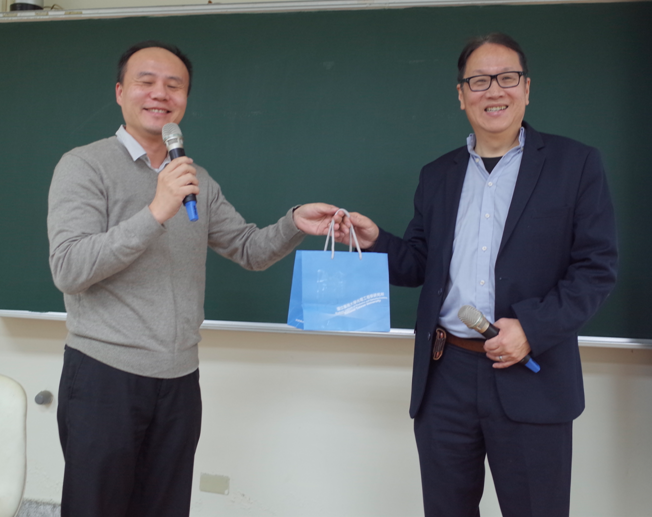 |
|
Professor Ray Chen (right) and GIPO Professor Guo-Dung Su (left) |
|
|
 |
|
 |
|
| |
|
 |
|
~ 2018 Ph.D. Student Academic Exchange with Nanjing University ~
(The 11th Cross-Strait Ph.D. Student
Forum on Photonic Science and Technology, 2018)
(Time: Nov. 7-11, 2018; Location: National Taiwan University)
Composed by
Dai-Jie Lin,
GIPO Ph.D. student
The cross-strait Ph.D. student forum on photonic science and technology is an important annual academic exchange event for GIPO, NTU. It has been held for 11 years since 2008. Because of our good long-term relationship with the School of Physics, Nanjing University, and through both schools’ constant endeavors, the forum has successfully lasted for 11 years. And, like Professor Chih-Chung Yang and Academician Shining Zhu said in their addresses to the forum, they both cordially hope that this meaningful event could last for 20 and even 30 years more. Both NTU and NJU take turns to sponsor the forum each year. The two schools’ research fields are different in many ways, but extensive exchanges and cultural visits, have led to more research inspiration and chances for cooperation between the two sides. This year, a total of 25 students participated in this 11th forum, including 15 outstanding students from the School of Physics, NJU, and 10 Ph.D. students from GIPO, NTU.
|
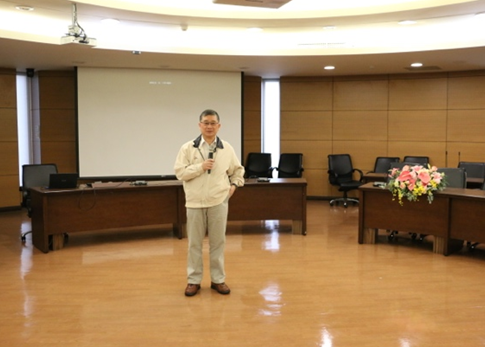 |
 |
|
Professor Chih-Chung Yang, NTU, addressing the forum |
Academician Shining Zhu, NJU, addressing the forum |
This year, under the full authorization of GIPO chairman Gong-Ru Lin and vice chairman Jian-Jang Huang, the exchange activities have all been planned and completed by the 10 NTU Ph.D. students involved. Ms. Hsiao-Wen Lin, GIPO office clerk, has further provided us with her past experience and necessary assistance, which made our efforts more efficient and focused. Before the forum, we held 4 preparatory meetings. From the very beginning of distributing students into groups and allotting work to each student, to planning the schedule for cultural visits and boarding, we discussed all the minute details in each meeting so as to ensure that the forum is carried out perfectly.
The forum lasted for 2 days with a full and exciting schedule, including two invited talks from professors at both schools, and 25 students’ research reports, all on par with those found at any international conferences. But unlike other dull conferences, we added a little something special to our forum. We distributed the 25 students into 5 groups, and each group competed with others for the final group-spirit prize. This way students are more keen to raise and answer questions, making for a more lively atmosphere and exchanges among group members.
|
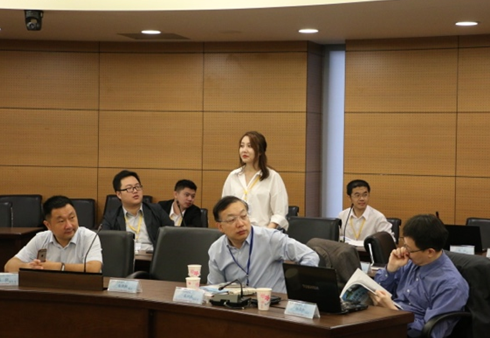 |
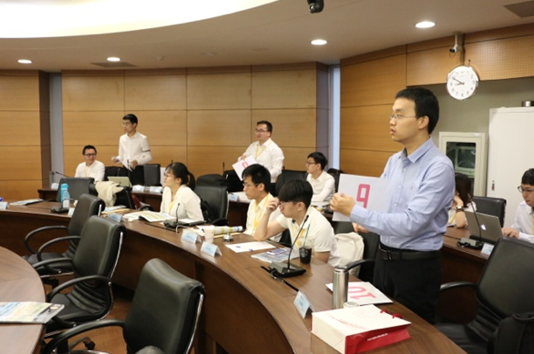 |
|
Xiao-Hui Tian, student, raises a
question |
Appraising each group’s performance |
For the students’ report, each student presented and discussed their research and answered questions over 15 minutes. However, due to too many questions being raised, many reports could not be in 15 minutes, which was something that had not come up in our preparatory meetings. In addition to students’ questions, both schools’ instructors, such as chairman Gong-Ru Lin and vice chairman Jian-Jang Huang raised questions as well, and vice dean Xing-Long Wu and vice president Zhenlin Wang of Nanjing University have also provided some suggestions for students’ reports. Through students’ reports, we not only got access to different research domains but also inspired different ideas in related domains. During the interchange, the students’ reports gave the audience very different impressions. NJU students provided a huge amount of information in 15 minutes and aimed to present all the results of their research. Consequently, they tend to be very confident although a little bit too fast in reporting. On the other hand, NTU students’ reports are more moderate in speed, and they constantly cast their vision to the audience to elicit interactions.
Aside from teachers’ research reports, there was another report during the next day’s lunch hours which impresses us very much, i.e., Chairman Gong-Ru Lin’s report concerning the introduction and history of Taiwan’s snacks. Everyone was so fascinated with his report, that while listening to and staring at the chairman, students seemed to have forgotten their own food in their dishes. At the end of the meeting, both schools’ team leaders, representing each school’s students, exchanged gifts. Everyone also voted for best thesis student, best relations with other students and best group-spirit prizes. Finally, amid students’ laughter over snacks of red-bean cake and pearl milk tea, the two-day forum drew to a close.
|
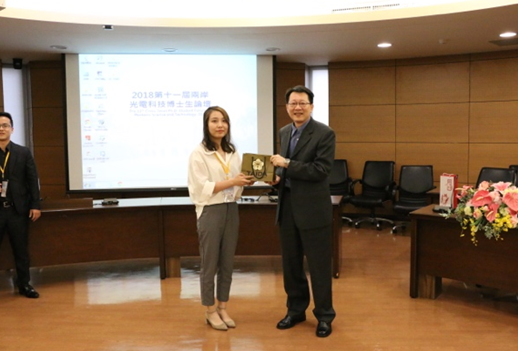 |
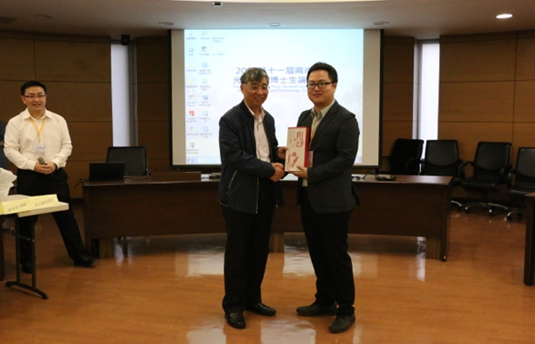 |
|
Xiao-Hui Tian, winner of NJU best
student thesis prize, and Chairman Gong-Ru Lin |
Chih-Hao Chuang, winner of NTU best student thesis prize, and Academician Shining Zhu
|
|
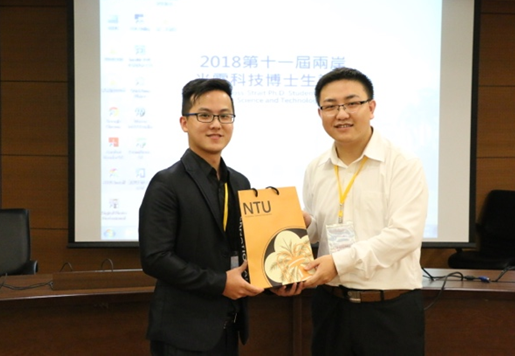 |
 |
|
Both team leaders, Ang-Sheng Chou and Hao Jing, exchange gifts |
A group photo of all NTU and NJU presented students |
|
|
 |
|
 |
|
| |
|
 |
Wire Electrical Discharge Machined Folded-Up Corner Cube Retroreflector
Professor Jui-che Tsai
Graduate Institute of Photonics and
Optoelectronics, National Taiwan University
We have developed an approach to construct a corner cube retroreflector (CCR). A two-dimensional cutout pattern is first fabricated with wire electrical discharge machining process. It is then folded up into a three-dimensional CCR suspended on a cantilever beam. The folded-up CCR may be driven through external actuators for optical modulation; it can also mechanically respond to perturbation, acceleration, etc., to function as a sensor. Mechanical (static and dynamic modeling) and optical (ray tracing) analyses are also performed.
© 2018 SPIE
Yu-Fan Chen, Yen-Hung Wang, Jui-che Tsai, “Study of wire electrical discharge machined folded-up corner cube retroreflector with a tunable cantilever beam,” Opt. Eng. 57(3), 035104 (2018)
Three Dimensional Simulation on the Transport and Quantum Efficiency of
UVC-LEDs with Random Alloy Fluctuations
Professor Yuh-Renn Wu's laboratory
Graduate Institute of Photonics and
Optoelectronics, National Taiwan University
The active regions of ultraviolet light emitting diodes (UVLEDs) for UVB and UVC wavelengths are composed of AlGaN alloy quantum barriers (QBs) and quantum wells (QWs). The use of alloy QBs and QWs facilitates the formation of percolative paths for carrier injection but also decreases carrier confinement within the QWs. We applied the recently developed Localization Landscape (LL) theory for a full 3D simulation of the LEDs. LL theory describes the effective quantum potential of the quantum states for electrons and holes in a random disordered system with a high computational speed. The results show that the potential fluctuations in the n-AlGaN buffer layer, QWs and QBs provide percolative paths for carrier injection into the top (p-side) QW. Several properties due to compositional disorder are observed: (1) The peak internal quantum efficiency (IQE) is larger when disorder is present, due to carrier localization, than for a simulation without fluctuations. (2) The droop is larger mainly due to poor hole injection and weaker blocking ability of the electron blocking layer (EBL) caused by the fluctuating potentials. (3) Carriers are less confined in the QW and extend into the QBs due to the alloy potential fluctuations. The wave function extension into the QBs enhances TM emission as shown from a k.p simulation of wave-functions admixture, which should then lead to poor light extraction. The work is published in Applied Physics Letter.
|
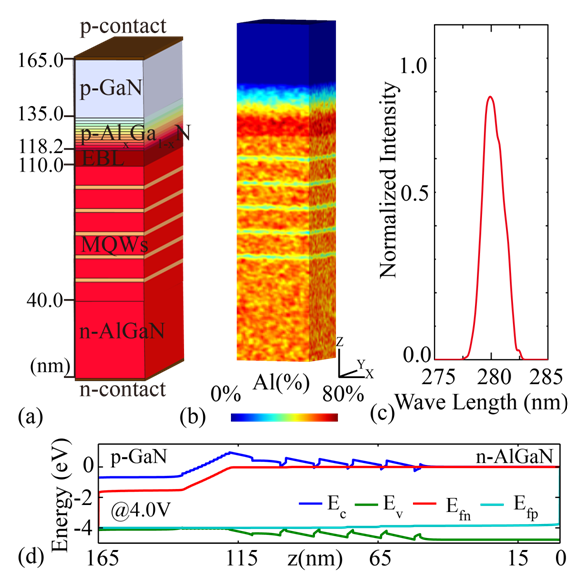
|
|
FIG.1. (a) Illustration of UVC-LED layer structures. Contacts are put on the top and bottom surfaces. The simulated device area is 30nm x 30nm. The thickness of QW and QB is 2 and 10nm, respectively. (b) Computed Al compositions in the AlGaN layers obtained by assuming a random alloy. (c) Emission peak calculated by averaging 10 different random maps for a single QW. (d)The band profile of UVC-LEDs without considering composition fluctuation. |
|

|
|
FIG. 2. Side view of (a) conduction band potential; (b) radiative recombination rate; (c) non-radiative recombination rate; (d) electron current density; (e) hole current density; and (f)
εxx. All maps at J=(4.7V,20A/cm2). The z direction is the growth direction of the epitaxial stack crystal c-axis. |
|
|
Investigating the opacity of corneal and scleral scattering medium via numerical solutions of Maxwell’s equations
Professor Snow H. Tseng
Graduate Institute of Photonics and
Optoelectronics, National Taiwan University
Similar in structure, the cornea and sclera both consist of collagen fibrils, yet, the opacity differs significantly. Here we employ numerical solutions of Maxwell’s equations to model light propagation through cornea-like and sclera-like scattering medium, respectively. By varying the specific structure of the scattering medium, we investigate geometrical factors that can account for the opacity, including wavelength, size and the position of the dielectric cylinders. The reported numerical analysis may shed light to understanding the opacity of scattering medium.
|
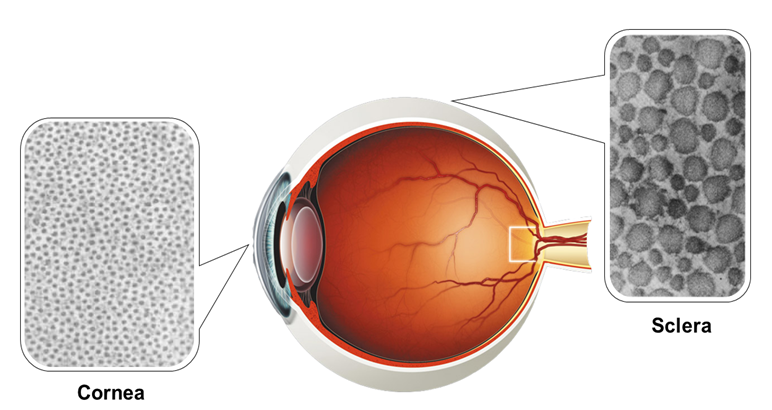
|
|
Fig. 1. Schematics of the geometrical structure of cornea and sclera of a human eye. The scleral collagen fibrils are irregular in shape and position, whereas the corneal collagen fibrils are smaller and regular in position.
[http://www.nikon-lenswear.com.tw/zh/eyes-and-vision/how-your-eyes-work]
[http://www.oculist.net/downaton502/prof/ebook/duanes/pages/v4/v4c023.html]
|
|
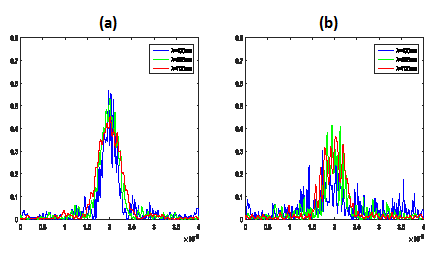 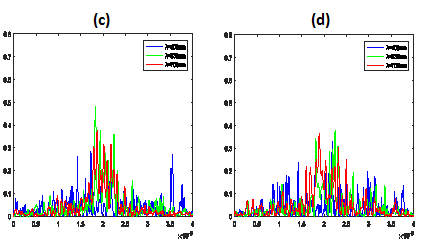
|
|
Fig. 2. Light transmission through
scattering medium diminishes with
increased constituent dielectric
cylinder diameter
d:
(a) 120 nm, (b) 200 nm, (c) 280 nm, and
(d) 360 nm. The amplitude and direction
propagation of light is randomized for
each wavelength. |
Broadband Silicon Photonics Polarization Beam Splitters Designed Using Genetic Algorithm
Professor Ding-Wei Huang
Graduate Institute of Photonics and
Optoelectronics, National Taiwan University
In this work, we present a design method for a directional coupler-type polarization beam splitter (PBS) for ultrabroadband operation based on a genetic algorithm (GA). The PBS is discretized into short sections, with the geometric parameters of each section optimized using a GA. For PBSs with an operating wavelength range
λ
= 1400–1650 nm, the insertion losses are less than 0.14 dB and 0.58 dB, and the maximum crosstalk is −20.6 and −16.2 dB for the TE and TM modes, respectively. Under the fabrication error of +/-10nm for the waveguide widths, the device shows negligible performance variation.
|
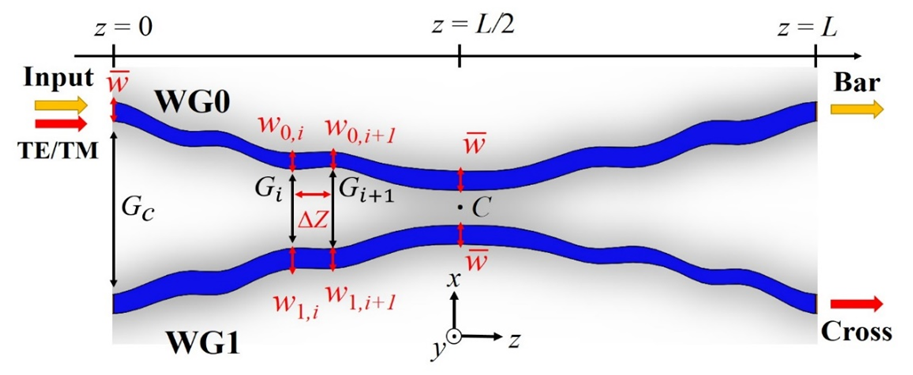
|
|
Fig. 1. Schematic of the Broadband silicon photonics polarization beam splitter. |
|
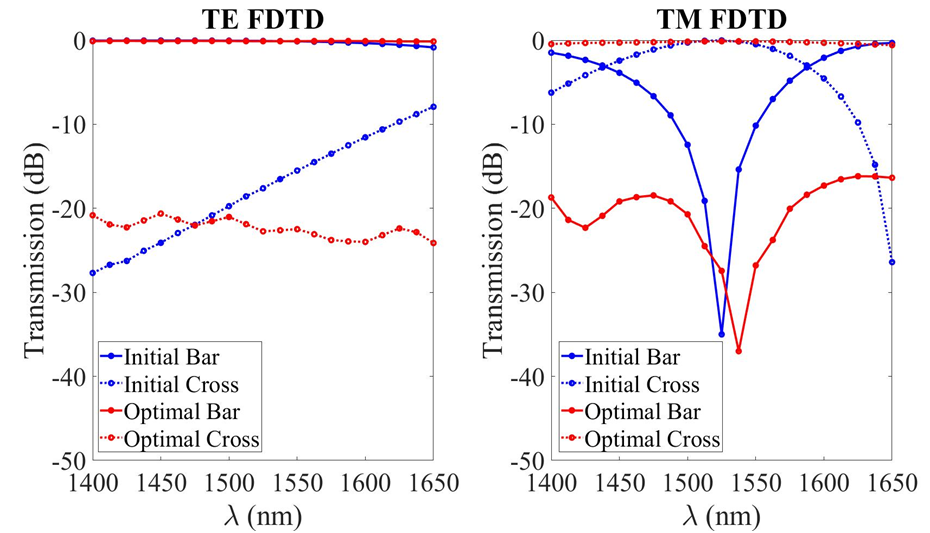
|
|
Fig. 2. Output power at the Bar and Cross ports for the TE and TM modes calculated by 3D-FDTD simulation. |
High Speed 850-nm Vertical Cavity Surface Emitting Lasers (VCSELs)
Professor Chao-Hsin Wu
Graduate Institute of Photonics and
Optoelectronics, National Taiwan University
850 nm vertical-cavity surface-emitting lasers (VCSELs) have been extensively applied on high-speed short reach optical network systems due to their characteristics like low divergence angle, cost-effective fabrication, small footprint, low power consumption and high modulation speed at low currents, which can be applied on high-speed datacenter and giga bit Ethernet.
We accomplished a 50 Gb/s operation of an 850 nm oxide-confined VCSEL with a 3.3 μm aperture diameter. The light- current- voltage curve of 850nm VCSEL with a 0.8 mA threshold current (Ith) and the 0.6 W/A slope efficiency, and the high differential resistance of 135 Ω due to the small aperture, which is shown in Fig.1. Fig.2 shows the optical response of the VCSEL with injected current of 4, 6, and 8mA, respectively, and the modulation bandwidth increases from 22.7 to 25 GHz. Fig.3(a) shows 50 Gb/s BER measurement at I/Ith of 13. The error-free data transmission (BER < 10-12) is achieved with received optical power of 1.7 mW and the corresponding eye diagram is shown in Fig. 3(b). The VCSEL shows an open eye at 50 Gb/s data rate without overshoot which means it can provide higher signal integrity without using pre-emphasis, equalization, and forward error correction. The energy/data efficiency is 748 fJ/bit at 50 Gb/s at room temperature.
|
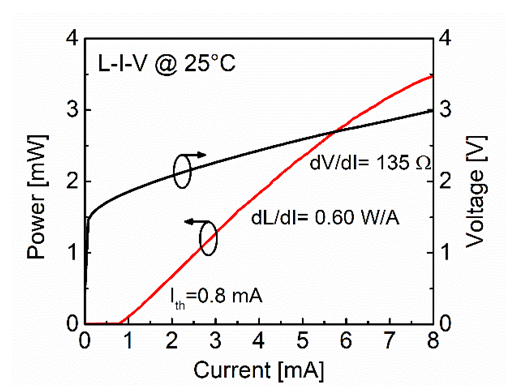
|
|
Fig. 1. The light-current-voltage (L-I-V) characteristics of 850 nm VCSEL. |
|
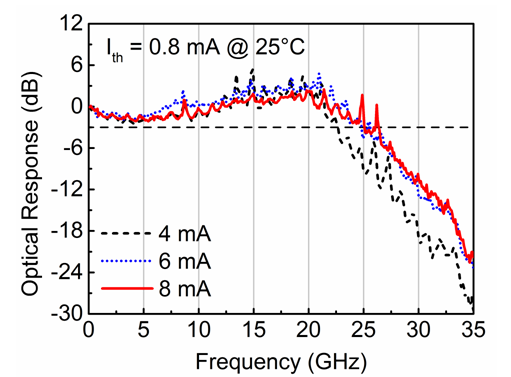
|
|
Fig. 2. Optical modulation of the VCSEL at various bias current. A 25 GHz bandwidth is obtained at I = 8 mA. |
|

|
|
Fig. 3. (a) The 50 Gb/s bit-error-rate-test (BERT) results of the 850 nm VCSEL biased at 11 mA (I/Ith~ 13) with PRBS7 bit sequence and Vpp = 1252 mV. (b) is the corresponding eye diagram. |
Three Dimensional Corrugated Electrode Structure for Low-voltage High-transmittance Blue-Phase Liquid Crystal Displays
Professor Wing-Kit Choi
Graduate Institute of Photonics and
Optoelectronics, National Taiwan University
We have recently proposed new electrode designs for corrugated Polymer-Stabilized Blue-Phase Liquid Crystal Display (PSBP-LCD). These new designs are based on the concept of three dimensional (3D) electrode structure which can help create extra electric field in the transverse direction (y-axis). These new designs can help enhance the potential transmission by reducing the dead zones that exist along the turning edges of these devices. By using suitable device parameters, it is possible to obtain high transmission T of > 90% at low operation voltage of ~10V. PSBP-LCD has many attractive features such as sub-millisecond fast response time, no need of alignment layer, wide-viewing angle etc., and has been actively researched as a potential technology for next-generation displays in recent years. Results of this research have recently been published in
Liquid Crystals
[1].
[1] Bing-Han Chan & Wing-Kit Choi (2018): Three-dimensional corrugated electrode structure for low-voltage high-transmittance blue-phase liquid crystal displays, Liquid Crystals, DOI: 10.1080/02678292.2018.1530385
|
|
|
|
 |
|
 |
|
| |
|
|
 |
|
 |
|
|
|